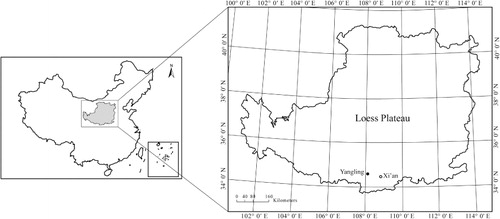Abstract
Soil crust formed after rainfall has a strong influence on soil erosion, water use, and crop growth on sloping farmland. To study the effect of soil crust on sloping farmland on runoff amount and erosion sediment yield, the soil crust on sloping farmland has been studied in this paper for plantings of corn, soybeans, millet, and winter wheat. Using an outdoor rainfall simulator, the influence of soil crust on runoff rate and sediment yield on sloping farmland covered by crops has been observed. The results revealed that soil crust thickness was increased after rainfall and soil crust coverage showed little change after rainfall. Soil crust had a significant impact on runoff and sediment yield on sloping farmland. Slopes with soil crust showed higher runoff rate and less soil loss than slopes without soil crust. On slopes planted with four crops (corn, soybeans, millet, and winter wheat), runoff rates on slopes with soil crust were respectively 20%, 25%, 25%, and 21% higher than on slopes without soil crust; sediment yield on slopes with soil crust was respectively 15%, 14%, 14%, and 8% lower than on slopes without soil crust. Crops enlarged the runoff difference between the two kinds of slope and decreased the sediment yield difference between them. Crop growth enhanced these differences in runoff and sediment yield between slopes with and without soil crust.
Introduction
Formation of soil crusts is a common phenomenon in the farmland in the Chinese Loess Plateau, and it occurs when a thin layer with low porosity is formed at the soil surface after rainfall or irrigation water application (Wu et al. Citation2014). Soil crust formed after rainfall affects not only runoff and sediment yield on slopes but also rain infiltration, rain evaporation, and soil moisture conditions (Morin et al. Citation1989; Römkens et al. Citation1986; Wu et al. Citation2014). Study of soil crust has been focused mainly on formation of soil crust under rainfall, on soil compactness and crust-development mechanisms under different moisture treatments, on patterns of change in the thickness, intensity, bulk density of crust, and on factors in crust development (Morin & Vanwinkel Citation1996; Shainberg et al. Citation2002, Citation2003; Wakindikia & Ben-Hur Citation2002; Lado et al. Citation2004; Neave & Rayburg Citation2007). The development mechanisms, formation process, and influencing factors of soil crust have been comprehensively studied, and researchers have believed that soil crust can decrease infiltration, increase runoff, influence sediment production, and reduce crop biomass and yield (McIntyre Citation1958a, Citation1958b; Chen et al. Citation1980; Moore Citation1981; Moore & Singer Citation1990; Levy et al. Citation1994; Li et al. Citation2005). Whether soil crust can promote sediment yield on slopes is still under discussion. Cai et al. (Citation1998) indicated that on sloping farmland with soil crust, it was easier to produce runoff and erosion. But Wu and Fan (Citation2005) found that the runoff amount increased, but sediment yield decreased. Wang et al. (Citation2008) believed that extensive sealing of the soil surface could reduce runoff and sediment yield. As an underlying surface with special properties, soil crust has a profound impact on runoff and sediment yield on sloping land, but the nature of these effects is still controversial, especially in Chinese Loess plateau.
Under artificial rainfall, it is difficult to form soil crust on shrubland and forested land, but easily formed on farmland, wasteland, and farmland which was previously wasteland (Robinson & Phillips Citation2001). Due to the short crop growth cycle and the presence of artificial influences, the impacts of crops on runoff and sediment yield on sloping farmland are significantly different from those on forest and grassland. It can be concluded that farmland has poor erosion resistance (Li et al. Citation2006). However, compared with bare soil (BS), farmland with crop cover reduced runoff and delayed runoff formation (Song et al. Citation1998). Singh (Citation2011) studied the influence of soybeans (Glycine max L.) and peanuts (Arachishypogaea Linn.) on sloping farmland and found that crops could decrease runoff by 29.6% and sediment yield by 27.7%. It is therefore apparent that erosion resistance on sloping land under crop cover was poor, and has the gap between different kinds of crop cover. In general, crops can promote erosion resistance on sloping farmland. Both crops and soil crust have a strong influence on soil erosion on slopes. As the main activity occurring on sloping farmland, cultivation affects the formation and function of soil crust. However, the combined actions between soil crust and crop planting in Chinese Loess Plateau have not been examined. This research has studied soil crust on sloping farmland covered with various crops and explored the influences of soil crust on runoff and sediment yield on sloping farmland, with the intention of providing a scientific basis for control of soil and water loss as well as reasonable use of soil and water resources in the Loess Plateau of China.
Materials and methods
Study area
The study area is located in the southern Loess Plateau, Shaanxi Province, China (N 34°14′–34°20′, E 107°59′–108°08′, ). The climate is continental monsoon with semi-humid, and the average annual temperature is 12.9°C. The warmest month is July, with an average temperature of 26.1°C; and the coldest month is January, with an average temperature of –1.2°C. The mean annual precipitation is 635.1 mm, mostly concentrated from July to September. The mean annual evaporation is 993.2 mm, and the moisture index is 0.64. Soils in the study area are Eum-Orthic Anthrosols, which are a kind of Cumulic soil in World Reference Base for Soil Resources (WRB). The size distribution and components of soil particles were 0.40% of 1–0.25 mm, 8.60% of 0.25–0.05 mm, 44% of 0.05–0.01 mm, 13% of 0.01–0.005 mm, 22% of 0.005–0.001 mm, and 12% of <0.001 mm (Lei et al. Citation2005). Vegetation is mainly humid and semi-humid temperate forest, but this does not exist in large amounts and has been replaced by farmland.
Observation experiments on outdoor runoff plots
Experiments were performed on runoff plots in the Soil and Water Conservation Engineering Laboratory of Northwest A&F University. An artificial rainfall simulator was used for observations in various crop growth stages. The four runoff plots were 4 m × 1 m with a slope of 10°. Two runoff plots were planted with crops according to local customs, and two bare runoff plots were used as the control group. In each observation stage, a soil auger (φ = 5 cm) was used to obtain soil samples for soil-moisture measurements in the runoff plots. One crop plot (A1) and one bare plot (B1) were thoroughly plowed to break the soil crust and then raked smooth. The other two plots were not plowed to maintain the soil crust (A2, B2, and ). A rainfall simulator was used to simulate rainfall in the four plots. When runoff was generated, runoff samples were collected for 1 min using polyvinyl chloride kegs. Collection of 1-min samples was performed every 2 min until rainfall ended. The collected runoff samples were taken to the laboratory for measurement of total volume. The samples were then allowed to settle for 24 h to remove the supernatant. The precipitated sediment was then dried at 105°C and weighed to obtain the sediment weight. Rainfall intensity was 80 mm/h, and the duration of each rainfall event was 60 min.
Crops were planted in the runoff plots from 2009 to 2010 and were also planted in outdoor experimental fields nearby the runoff plots at the same time to observe the leaf area index (LAI). The land was plowed before planting, and other management measures were consistent with local customs. Patterns and time of planting for various crops are provided in .
Table 1. Planting patterns and time of various crops.
The rainfall-generation machine used an artificial side-spray device made by the Ministry of Water Resources, Water and Soil Preservation Institute in the Chinese Academy of Science (). The machine consisted of a rainfall system and a water-supply system. The rainfall system was made up of two single rainfall shelves, with each shelf including a side-sprayer, a sprayer shelf, and a pressure-control component. The rainfall sprayer was made up of a sprayer body, a tatter-flow baffle, an outflow pore plate, and other components. The sprayer part was placed on the shelf and fixed by a tripod. The spray head was 6 m high, the water sprayed out of it reached 7.5 m high, and the effective area covered was 5 × 7 m2. The final velocity of the rainfall machine was close to the natural speed of rainfall, and the average rainfall evenness was higher than 80%. Water pressure was controlled by a pressure gage, and rainfall intensity was controlled by the pore-plate aperture. When the aperture was 3–10 mm, the rainfall intensity could be varied from 30 mm/h to 140 mm/h.
Crust measurement
In the plots with soil crust, three typical zones were selected from the top, middle, and bottom of each slope, and each zone was fixed with plank frames (30 cm × 30 cm). Then a digital camera was used to take high-definition photos of the soil crust under the same mode, height, and angle (vertical), and the area and degree of coverage of the soil crust coverage (SCC) were calculated using the Image J software. Soil crust samples were collected from the plots with soil crust and taken to the laboratory for thickness measurement using a Vernier caliper. Three soil crust samples (with area of 10 cm2) were taken in upper slope, middle slope, and lower slope, respectively. Each sample in the same plot was measured 15 times and the average soil crust thickness (SCT) was calculated.
LAI measurement
After artificial rainfall experiments for crops in various stages, the length–width proportion method was used to measure the leaf area of the corn, soybeans, and millet. Then the total LAI was calculated according to equation 1:
Statistical analysis
The IBM SPSS statistics 20.0 (IBM Inc.) software was used in statistical analysis of the data. A paired t-test (α = 0.05) was used to explore the significance of the effect of rainfall on the soil crust, and the effect of soil crust on the time producing runoff, runoff rate, sediment yield, and sediment concentration. One-way analysis of variance was used to explore the significance of the effect of LAI on the soil crust, the time producing runoff, runoff rate, sediment yield, and sediment concentration.
Results
Due to the influence of soil and rainfall, soil crust generally exists on sloping farmland. The compact crust structure reduces rainfall infiltration and has a major effect on runoff and sediment yield on slopes. Meanwhile, crop canopies can influence the formation and development of soil crust to some degree, thus further affecting runoff and sediment yield on slopes with crop cover.
Change of soil crust under crop cover
Crops can affect SCT and SCC. The change of SCT before and after rainfall for various crops and growth stages are illustrated in . Under corn, soybean, millet, and winter wheat canopy cover, the average SCT was increased by 54.06%, 11.19%, 8.37%, and 7.85% after the rain, respectively. This indicated that although the soil was covered by crops, rainfall still affected the soil crust and increased SCT. SCT was measured 15 times for the top, middle, and bottom of the sloping land in each runoff plot, and the coefficient of variation (CV) was then calculated. The CV value increased with crop growth, and the CV of corn varied from 0.21 in the seedling stage to 0.34 in the tasseling stage; for soybeans varied from 0.21 in the seedling stage to 0.24 in the initial pod-filling stage. The CV of millet varied from 0.21 to 0.32 and that of winter wheat from 0.19 to 0.32. The average CV of SCT in different growth stages under crop cover was generally higher than for BS, which was 0.17 on average. This indicated that crops increase the variability of the SCT distribution on soil surfaces under crop cover between rows and that with crop growth, the variability of the SCT distribution gradually increased. The randomness of the rate of change of SCT before and after rainfall was related to the variability in the SCT distribution. Because of this distribution variability, SCT exhibited randomness and uncertainty. Generally, SCT increased after rainfall, but did not show regular change with increasing LAI. As shown in , the change of SCT after rain under corn and soybean cover was larger than that under millet and winter wheat cover. Higher crop-planting density means more compact cover, and the millet and winter wheat canopies were low, which greatly weakened the impact of raindrops on the surface soil and impeded the increase in SCT with rainfall, especially on soil surfaces covered by winter wheat. On the other hand, with a relatively lower planting density and a high canopy, corn has a relatively inferior ability to weaken erosion by rainfall kinetic energy, and the rate of change of SCT due to rainfall became larger.
Note: SL, stubble field; BS, bare soil.
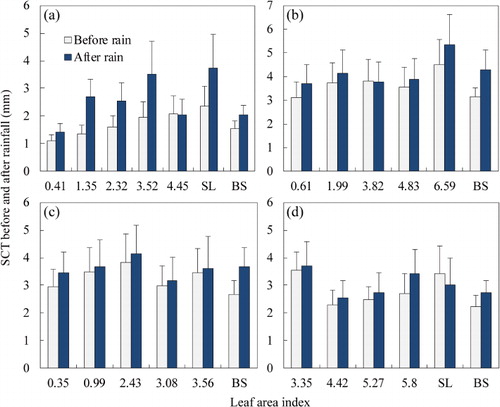
The SCC after the rain was respectively increased by 0.68%, 0.74%, and 0.35% under corn, millet, and winter wheat cover, but decreased by –0.08% under soybean cover (). After the first rainfall during the observation period, SCC increased rapidly because the soil crust before the first rainfall had been formed by natural rainfall during the period from the crop-sowing stage to the first simulated rainfall experiment. The intensity of natural rainfall was relatively low, thus the SCC formed by natural rainfall was less. The rainfall intensity in the experiments was larger; therefore, the SCC increased quickly after the first simulated rainfall and then decreased in the middle and later crop-growth stages. This probably occurred because the SCC was partly influenced by slope gradient. Because of the steep slope and fast runoff speed, combined with the fact that the soil crust promoted fast runoff, the runoff tended to break the soil crust. In the middle and later crop-growth stages, the soil surface was extensively covered by high-strength crust, and rill erosion marks had been widely formed by passing rainfall. These could have promoted runoff collection and accelerated runoff, thus intensifying runoff to break the soil crust and decreasing the soil crust. However, in the stubble stage of corn and winter wheat, crop cover became thinner, and the influence of raindrop impacts on surface soil was intensified. Therefore, SCC after rainfall was increased.
Note: SL, stubble field; BS, bare soil.
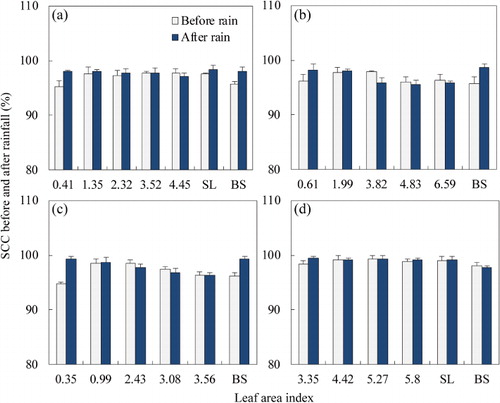
According to the results from analysis of variance, with crop canopy cover, the SCT showed a significant difference before and after rainfall (P < 0.05) except corn canopy (P > 0.05); the SCC showed no significant difference before and after rainfall under crop canopy cover (P > 0.05). Generally, the change in SCT is smaller after rainfall under crop cover, is little influenced by crop growth, and shows a certain degree of randomness. Under a crop canopy, the distribution of SCT became less homogeneous, and the SCC became smaller and even more negative.
Influence of soil crust on runoff and sediment yield
The influences of soil crust on runoff and sediment yield on runoff plots in different growth stages of various crops are given in .
Table 2. Influences of soil crust on runoff and sediment yield in different growth stages of various crops.
According to the results from analysis of variance, under crop canopy cover, the time producing runoff, runoff rate, sediment yield, and sediment concentration in plots with soil crust showed highly significant differences from plots without soil crust (P < 0.01). Whether or not a slope had a soil crust before rainfall, the time producing runoff, runoff rate, sediment yield, and sediment concentration showed extremely significant variations among crops (P < 0.001). Under crop canopy cover, the time producing runoff showed no difference with changes of LAI in each plot (P = 0.913). Runoff rate, sediment yield, and sediment concentration showed extremely significant differences with changes of LAI (P < 0.01). This means that both soil crust and crop cover have a strong influence on runoff and sediment yield on sloping land.
Soil crust advanced the time producing runoff (). With crop growth, the time producing runoff on slopes without soil crust were markedly postponed. Under a slope gradient of 10°, runoff rate on BS with soil crust was 5.27% higher than that without soil crust. However, sediment yield was 27.66% lower than that without soil crust, and sediment concentration was 25.42% lower than that without soil crust. This indicates that the presence of a soil crust before rainfall could increase runoff rate and decrease sediment yield on sloping land. Compared with BS, under corn cover, the average runoff rate on slopes with soil crust was 40.06 mm/h, which was 19.85% higher than on slopes without soil crust; the average sediment yield on slopes with soil crust was 212.9 g/m2·h, which was 15.48% lower than on slopes without soil crust. Sediment concentrations were significantly different. Sediment concentrations on slopes with soil crust averaged 42.88% lower than on slopes without soil crust. Over the whole growth stage of corn, the differences between these two kinds of slope were significant. In addition, the increase in runoff rate on slopes with soil crust ranged from 10.81% in the seedling stage (LAI = 0.41) to 30.66% in the tasseling stage (LAI = 4.45) compared with slopes without soil crust, and the decrease in sediment yield on slopes ranged from 24.56% in the seedling stage to 5.92% in the tasseling stage. This means that the corn plants could enlarge the runoff gap between slopes with and without soil crust and that the gap became gradually wider with corn growth. As for sediment yield, the corn plants narrowed the gap between slopes with and without soil crust, and this gap was further reduced with corn growth.
Soil under soybeans, millet, and winter wheat obeyed rules similar to those for corn. Under soybean cover, the increase in runoff rate on slopes with soil crust compared with slopes without soil crust increased from 10.81% in the seedling stage (LAI = 0.61) to 30.16% in the initial pod-filling stage (LAI = 6.59). The sediment yield difference between the two kinds of slope decreased from 15.05% in the seedling stage to 8.66% in the initial pod-filling stage. Under millet cover, the runoff rate difference between the two kinds of slope increased from 13.73% in the seedling stage (LAI = 0.35) to 31.31% in the pod-bearing stage (LAI = 3.56). However, the sediment yield decreased from 16.70% to 3.68%. Under winter wheat planting, the runoff rate difference between the two kinds of slope was similar to those for the other three crops. Runoff increased from 11.43% in the seedling establishment stage (LAI = 3.35) to 33.80% in the grain-filling stage (LAI = 5.80), and 12.35% in the stubble harvest stage. However, the gap in sediment yield on slopes with soil crust was relatively small compared with slopes without soil crust, and the gap remained small in the various growth stages. Because water-retention capability was stronger than for other crops, sediment yield and runoff rate were minimized.
Crops gradually decreased sediment yield and runoff rate on sloping land, meanwhile soil crust made the surface smooth, thus sped up runoff, reduced soil infiltration, and maintained a relatively higher runoff rate on slopes with soil crust. Because of the special structure of the soil crust and its strong resistance to erosion, these slopes had relatively strong soil erosion durability and soil anti-scourability, thus decreased sediment yield. Combined with the impediment of crop on the formation of sediment and runoff, slopes with soil crust had lower soil erosion. Compared with slopes with soil crust, slopes without soil crust were rough, could effectively impede runoff, and increase soil infiltration. Consequently, slopes without soil crust had less runoff than slopes with soil crust. Moreover, slope runoff decreased gradually with crop growth, and the increase in magnitude was larger than on slopes with soil crust, thus the runoff rate difference between the two slopes became steadily larger. Dispersed soil on the rough surface could be washed away by runoff easily and increased soil erosion on the slope without soil crust. In the seedling stage of crops, young plants could not provide much protection for the soil surface, sediment yield on slopes without soil crust was much larger than on slopes with soil crust. With crops growth, the larger plants could play a greater role in impeding runoff. Crop canopies could extend soil sealing process, maintain the rough soil surface for a long time, thus increasing infiltration and greatly reducing sediment yield on slopes. The gap between slopes with and without soil crust was thereby decreased. The presence of crops was able to enlarge the runoff gap and decrease the sediment yield gap between slopes with and without soil crust. Note that winter wheat could impede runoff to a large extent and decrease both sediment yield and runoff. Therefore, the presence of soil crust in this case had a relatively weak influence on sediment yield and runoff, and the winter wheat plants played a leading role in the variation of sediment yield and runoff on slopes.
Influence of soil crust on the formation process of runoff and sediment yield
Soil crust had a strong influence on sediment yield and runoff formation processes (–). Under corn cover, the formation processes of sediment yield and runoff showed significant differences between slopes with and without soil crust (, , ). On the whole, the process curves for sediment yield and runoff on slopes with soil crust were smooth, while the process curves for slopes without soil crust fluctuated greatly. The times producing runoff on slopes without soil crust were postponed, with runoff beginning when precipitation reached 38.56 mm. However, the times producing runoff was relatively earlier on slopes with soil crust: runoff began when precipitation reached 5.27 mm. However, the positions of the initial points of sediment yield and runoff rate at the beginning of the curves for the two slopes were almost the same. The initial point positions of sediment yield and runoff rate for slopes with soil crust were a little lower than for slopes without soil crust. The curves rose gradually after the beginning of runoff on slopes with soil crust, remained stable after 27 minutes, and then varied gently. The fluctuations of runoff and sediment process curves were more intense when runoff was formed on slopes without soil crusts and on soil crusts just beginning to form as rainfall continued under a corn canopy. The process curves entered a stable stage 47 min after runoff began. Because the runoff and sediment formation process curves for slopes without soil crust exhibited large fluctuations, sediment concentrations also showed drastic fluctuations over time. On the other hand, fluctuations in runoff and sediment formation processes curves were relatively gentle for slopes with soil crust.
Note: Take an individual crop growth stage as an example, 4.45 of LAI with corn, 6.59 of LAI with soybean, 3.56 of LAI with millet, and 5.80 of LAI with winter wheat. Take an individual bare slope as an example at the same stage of corn. Same growth stages in and . BS-Crust cover, bare soil with soil crust; BS-No crust, bare soil without soil crust; Crop-Crust cover, crop land with soil crust; Crop-No crust, crop land without soil crust.
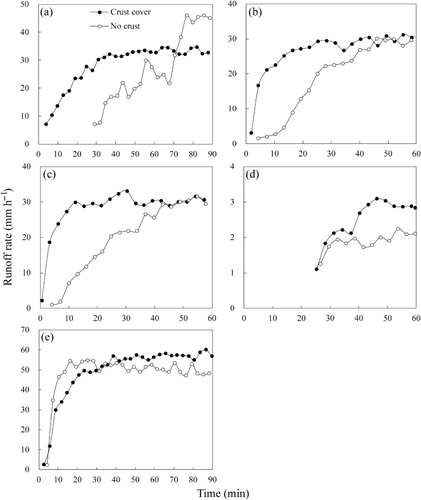
Note: Take an individual crop growth stage and BC as an example, growth stages are the same to those in . BS-Crust cover, bare soil with soil crust; BS-No crust, bare soil without soil crust; Crop-Crust cover, crop land with soil crust; Crop-No crust, crop land without soil crust.
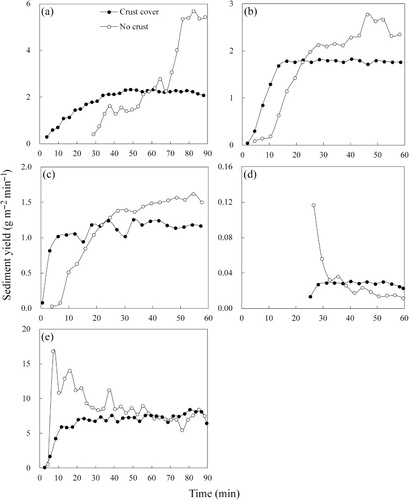
Note: Take an individual crop growth stage and bare soil as an example, growth stages are the same to those in . BS-Crust cover, bare soil with soil crust; BS-No crust, bare soil without soil crust; Crop-Crust cover, crop land with soil crust; Crop-No crust, crop land without soil crust.
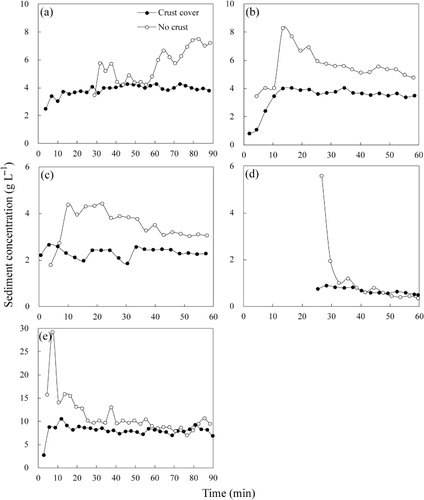
Under soybean, millet, and winter-wheat planting, variations in runoff and sediment formation processes on slopes (with and without soil crust) were almost the same as on slopes under corn cover (–). The runoff and sediment formation processes curves rose rapidly in a short time and remained in a stable state until the end of rainfall for slopes with soil crust. Moreover, because rough surfaces impeded runoff and sediment on slopes without soil crust, the curves rose slowly over a long time after runoff started, with drastic fluctuations. Meanwhile, because of the combined influence of rainfall and runoff, the loose soil gradually became compacted and formed a crust. This not only made the runoff and sediment formation processes fluctuate widely but also made the rough surface smooth with ongoing rainfall. Thus, it accelerated runoff move down and kept runoff and sediment formation processes stable – once a certain area of soil crust had formed on a slope, runoff and sediment formation stabilized. Crops affect runoff and sediment yield in two ways. On the one hand, crops increase infiltration on a slope and decrease runoff and sediment yield. On the other hand, crops decrease soil crust damage by rainfall and runoff on slopes with soil crust and maintain the degree of surface roughness for a relatively long time on slopes without soil crust. The sealing of surface soil was slowed down and became conducive to runoff infiltration, thus reducing the sediment carrying capability of runoff.
Discussion
Under the combined influence of soil and rainfall, soil crust has developed widely on soil surfaces in sloping farmland and has had major effects on soil erosion, water use, and crop growth. Under crop planting, SCT increased by 20% on average and SCC increased by 0.4% on average after rainfall. Under crop canopy cover, the average runoff rates on slopes with soil crust were 23% higher than on slopes without soil crust, and average sediment yield on slopes with soil crust were 13% higher than on slopes without soil crust. Crops enlarged the runoff difference between the two kinds of slope and decreased the sediment yield difference between them. Crop growth enhanced these differences in runoff and sediment yield between slopes with and without soil crust.
Shear stresses on the soil surface were enhanced through surface-soil compaction when a soil crust was formed, thus reducing splash erosion. Moreover, the presence of a crust increased runoff by decreasing infiltration, markedly reduced the critical rainfall intensity, and increased the kinetic energy of runoff on the crusted soil surface; thus, runoff and sediment yield were increased, and the possibility of rill erosion was also increased, which increased runoff and sediment yield to a substantial degree (Cai et al. Citation1990). These results for increased runoff with a soil crust obtained in this study are in accord with those from other researchers (Moore Citation1981; Cai et al. Citation1990; Wu & Fan Citation2005; Wang et al. Citation2008). There is no doubt that the presence of a soil crust can increase runoff on soil surfaces and reduce water use by crops. However, planted crops have an active impact on controlling soil erosion on slopes. The conclusions obtained here about the effect of soil crust on sediment yield were similar to those of Wu and Fan (Citation2005) and Wang et al. (Citation2008), but contrary to the research results of Cai et al. (Citation1990). The differences of soil texture and experimental conditions were the major reason. Whether or not a soil crust can increase soil erosion is still a topic for discussion. The influence of a soil crust on soil erosion varies widely because of differences in soil type, terrain, rainfall, and crops, which make the influence of soil crust complex and variable. Studying the influence of soil crust on soil erosion is conducive to illustrating the effective mechanisms of soil crust in soil-erosion research and thus guiding agricultural production.
Funding
This work was supported by the National Basic Research Program of China [grant number 2007CB407201-5]; National Natural Science Foundation of China [grant number 41330858] and [grant number 41101268].
Additional information
Funding
References
- Cai QG, Wang GP, Chen YC. 1998. Process and simulation of watershed sediment yield in Loess Plateau. Beijing: Science Press. Chinese.
- Cai QG, Wu SA, Chen H, Zhu TX, Lu ZX. 1990. Effect of soil surface crust on runoff and sediment processes on sloping farmland. In: Research letters of mechanism of soil erosion in western Shanxi in Loess Plateau. Beijing: China Water Power Press; p. 48–57. Chinese.
- Chen Y, Tarchitzky J, Brouwer J, Morin J, Banin A. 1980. Scanning electron microscope observations on soil crusts and their formation. Soil Sci. 130:49–55. 10.1097/00010694-198007000-00008
- Lado M, Ben-Hur M, Shainberg I. 2004. Soil wetting and texture effects on aggregate stability, seal formation, and erosion. 68:1992–1999.
- Lei TW, Liu H, Pan YH, Zhao J, Zhao SW, Yang YH. 2005. The runoff-inoff-runoff measurement method and model of soil infiltration capability in slope land. Sci China Ser D Earth Sci. 35:1180–1186. Chinese.
- Levy GJ, Levin J, Shainberg I. 1994. Seal formation and interrill soil erosion. Soil Sci Soc Am J. 58:203–209. 10.2136/sssaj1994.03615995005800010030x
- Li M, Song XY, Shen B, Li HY, Meng CX, Song XY, Shen B, Li HY, Meng CX. 2006. Influence of vegetation change on producing runoff and sediment in gully region of Loess Plateau. J Northwest Sci-Tech Univ Agric For (Nat Sci Edn). 34:117–120. Chinese.
- Li XY, González A, Solé-Benet A. 2005. Laboratory methods for the estimation of infiltration rate of soil crusts in the Tabernas Desert badlands. Catena. 60:255–266. 10.1016/j.catena.2004.12.004
- McIntyre DS. 1958a. Permeability measurements of soil crusts formed by raindrop impact. Soil Sci. 85:185–189. 10.1097/00010694-195804000-00002
- McIntyre DS. 1958b. Soil splash and the formation of surface crusts by raindrop impact. Soil Sci. 85:261–266. 10.1097/00010694-195805000-00005
- Moore DC, Singer MJ. 1990. Crust formation effect on soil erosion processes. Soil Sci Soc Am J. 54:1117–1123. 10.2136/sssaj1990.03615995005400040033x
- Moore ID. 1981. Effect of surface sealing on infiltration. Trans ASAE. 24:1546–1561. 10.13031/2013.34488
- Morin J, Keren R, Benjamini Y, Ben-Hur M, Shainberg I. 1989. Water infiltration as affected by soil crust and moisture profile. Soil Sci. 148:53–59. 10.1097/00010694-198907000-00006
- Morin J, Vanwinkel J. 1996. The effect of raindrop impact and sheet erosion on infiltration rate and crust formation. Soil Sci Soc Am J. 60:1223–1227. 10.2136/sssaj1996.03615995006000040038x
- Neave M, Rayburg S. 2007. A field investigation into the effects of progressive rainfall-induced soil seal and crust development on runoff and erosion rates: The impact of surface cover. Geomorphology. 87:378–390. 10.1016/j.geomorph.2006.10.007
- Robinson DA, Phillips CP. 2001. Crust development in relation to vegetation and agricultural practice on erosion susceptible, dispersive clay soils from central and southern Italy. Soil Tillage Res. 60:1–9. 10.1016/S0167-1987(01)00166-0
- Römkens MJM, Baumhardt RL, Parlange MB, Whisler FD, Parlange JY, Prasad SN. 1986. Rain-induced surface seals: their effect on ponding and infiltration. Ann Geophys. 4:417–424.
- Shainberg I, Levy GJ, Mamedov AI. 2002. Prewetting rate and sodicity effects on soil permeability and surface sealing. Acta Hortic. 573:21–28.
- Shainberg I, Mamedov AI, Levy GJ. 2003. Role of wetting rate and rain energy in seal formation and erosion. Soil Sci. 168:54–62. 10.1097/00010694-200301000-00007
- Singh RK, Panda RK, Satapathy KK, Ngachan SV. 2011 Simulation of runoff and sediment yield from a hilly watershed in the eastern Himalaya, India using the WEPP model. J Hydrol. 405:261–276. 10.1016/j.jhydrol.2011.05.022
- Song XY, Li YJ, Chen HS, Hu XT, Shi WJ. 1998. A field experiment study on farmland rainfall, infiltration and runoff under different underlayer surface conditions in hilly areas of Loess Plateau. Agri Res Arid Areas. 16:68–75. Chinese.
- Wakindikia IIC, Ben-Hur M. 2002. Soil mineralogy and texture effects on crust micromorphology, infiltration, and erosion. Soil Sci Soc Am J. 66:897–905. 10.2136/sssaj2002.8970
- Wang H, Wang QJ, Shao MA, Li YY. 2008. Impact of soil crust on runoff, sediment and nutrient loss from sloping land. J Soil Water Conser. 22:35–38. Chinese.
- Wu FQ, Fan WB. 2005. Effects of soil encrustation on rainfall infiltration, runoff and sediment generation. Sci Soil Water Conser. 3:97–101. Chinese.
- Wu QJ, Wang LH, Wu FQ. 2014. Tillage – impact on infiltration of the Loess Plateau of China. Acta Agric Scand Sect B. 64:1–9.

